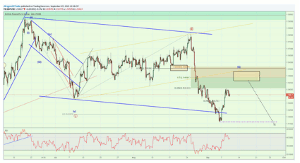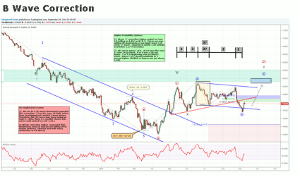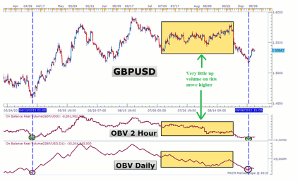Jeremy Wagner, of DailyFX Education, uses technical analysis to study a potential bearish third wave set to unfold soon in this currency pair as well as a different bullish wave count that is valid as well. Jeremy reviews both counts and discusses why his preference is for the bearish third wave count.
Talking Points:
- Bearish third wave of third wave Elliott Wave Count
- Bullish B wave Elliott Wave Count
- How to determine which one is the preferred count.
According to Elliott Wave Theory, the third wave is typically the one traders seek out and focus on for timing trades. The third wave of an eight wave Elliott sequence (five in the trend’s direction and three countertrend) is where the trader is aligned in the trend’s direction and has a large portion of the move left. Therefore, it offers traders an excellent risk:reward ratio opportunity.
Thursday, we will unpack a potential bearish third wave set to unfold soon in theGBP/USD as well as a different bullish wave count that is valid as well. We’ll review both counts and discuss why my preference is for the bearish third wave count.
Bearish Third Wave
This is the preferred wave picture for the GBP/USD is noted above. Red circle wave (ii) ended on August 25, which means red circle wave (iii) is in the early stages of a sell-off and should divide into five waves lower.
It appears the first of those five waves lower finished forming on September 4, which is labeled as blue wave (i). Therefore, we appear to be working on wave (ii) higher that could terminate at any moment, but appears to have some unfinished business to take care of in the 1.55 handle.
This wave count becomes stressed on a move above 1.5650. That is the point where blue wave (ii) would be larger than red circle wave (ii) in pips. There are not any Elliott Wave rules which suggest this cannot happen. However, from a practical standpoint, blue wave (ii) is a smaller degree of trend and should therefore not greatly exceed the same wave at larger degree.
If this wave pattern plays out, it suggests much lower prices coming to 1.49 and possibly 1.35 on an extreme move.
The bullish alternate view is that we have been stuck in a complex correction. The blue circle (b) wave was a zig zag or flat and we could be in the beginning stages of this last circle (c) wave higher. This pattern is difficult to time an entry on because the (B) wave has options and could extend lower to 1.49.
NEXT PAGE: The Three Items Tipping the Scale Towards the Third Wave
|pagebreak|Additionally, with the alternate count being a potential third wave of a third wave lower, we don’t want to get caught on the wrong side of the market should this (B) wave alternate prove to be incorrect.
Why Bearish Third Wave Is Preferred
As Elliott Wave technicians, we need to have alternate views at hand. So how do we distinguish a preferred count from an alternate count? Look for other readings through indicators or oscillators to tip the scales.
There are three items tipping the scales towards the third wave bearish count.
- On Balance Volume (OBV) suggests heavy selling internally which is bearish
- SSI (Speculative Sentiment Index) is +1.75 which is a bearish signal
- Waves down have been in five sub-waves…waves up have been three subwaves which suggests the trend is trying to form lower
First, the OBV readings on both the daily chart and 2-hour chart are bearish. Notice how the OBV readings are near the lows seen in April 2015 yet price is at a significantly higher level relative to April. This is because the volume on the up move (yellow box) was light as prices were moving higher. Coincidentally, as prices dropped during the yellow box, it occurred on heavy volume. As a result, we get an OBV line that is pressing lows near April.
Secondly, the sentiment readings gauged through the SSI are bearish. Currently, as of Thursday, SSI shows +1.75, which means 64% of the traders are currently long the pair. These traders have already committed to their position and become a future supply of sellers when they decide to close their trade. Therefore, a +1.75 SSI reading is a bearish signal suggesting gains in the pair may be temporary.
Lastly, remember, R.N. Elliott discovered that five waves determine the direction of the trend. Therefore, if we map out the 3's and 5's, the only hint of five waves comes to the downside.
Just like when we look at only a couple pieces of a jigsaw puzzle, we begin to see the picture but we don’t see everything. Therefore, the interpretation of what the image is on the jigsaw puzzle could be incorrect. That analogy applies to trading as well.
Though these clues above give us insight as to what the picture may look like, it is probabilistic and not certain of the outcome. A move above 1.5650 will stress the third wave count and lean us towards the bullish alternate.
By Jeremy Wagner, Head Forex Trading Instructor, DailyFX Education
























